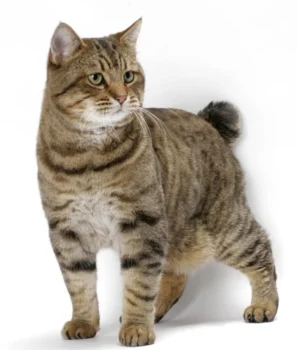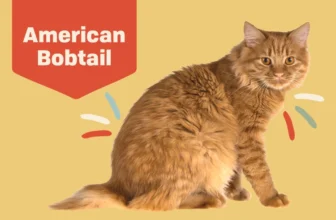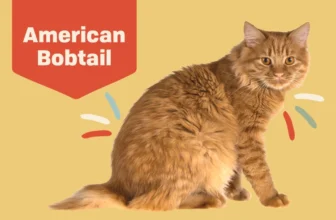As you search for the perfect feline companion, you may have come across the American Bobtail breed. Known for their unique physical features and affectionate personalities, these cats have become increasingly popular among pet owners. However, before welcoming one of these furry friends into your home, it’s important to understand the distinctive facial features that set them apart from other breeds. From their distinct head shape to their expressive eyes, let’s take a closer look at the American Bobtail’s facial features and what makes them truly unique.
Understanding the American Bobtail’s Facial Features
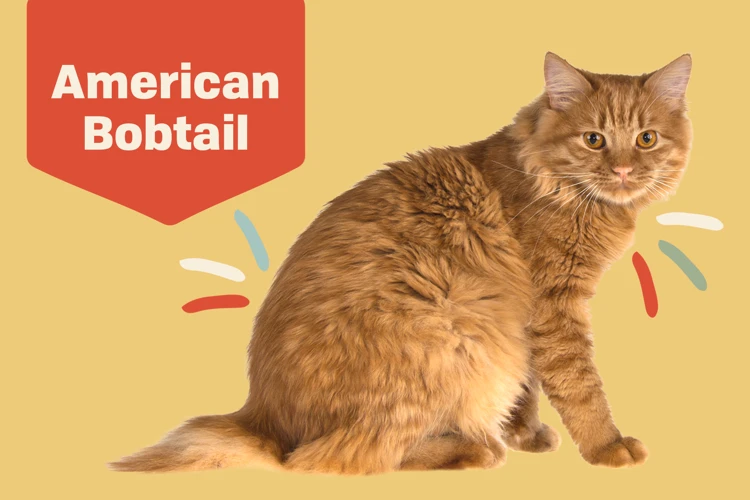
The facial features of the American Bobtail breed are truly unique and fascinating. From their head shape to their distinctive paws, each feature holds a special characteristic that distinguishes it from other feline breeds. Understanding these features is key to identifying an American Bobtail cat and appreciating their unique appearance. In this section, we will dive into the various facial features of the American Bobtail breed and explore why they make this breed so special. If you’re curious about how to identify an American Bobtail based on their facial features, check out our guide on identifying American Bobtail cat facial features.
Head Shape
When it comes to American Bobtail cats, one of their standout facial features is their unique head shape. Their head is broad and round, with high cheekbones and a distinct muzzle. This breed also has a strong jaw, with a noticeable curve towards the chin. Another defining feature of the American Bobtail’s head is their large, expressive eyes, which are set wide apart.
To highlight the distinctiveness of their head shape, we can compare it to other cat breeds. For example, the Siamese cat’s head is triangular and slender, while the Persian cat has a round head with short ears. The chart below breaks down the key differences between American Bobtail cats and other popular breeds:
| Cat Breed | Head Shape | Ears | Eyes |
|---|---|---|---|
| American Bobtail | Broad and round, with high cheekbones and distinct muzzle | Medium-sized, slightly pointed | Large and expressive, set wide apart |
| Siamese | Triangular and slender | Large and pointed | Oval-shaped and slightly slanted |
| Persian | Round head with short ears | Small and round-tipped | Large, round, and set wide apart |
As we can see, the American Bobtail’s head shape truly sets them apart from other breeds. This distinct head shape is a result of selective breeding over time, resulting in a unique and recognizable look. To learn more about the fascinating history of how the American Bobtail’s facial features evolved, check out our article on American Bobtail facial evolution.
Ears
The American Bobtail breed is known for its unique facial features, and one of the most prominent features are their ear tufts. The tufts are made of longer hairs that grow out from the tips of their ears, creating a distinctive and wild look. These tufts are more prominent in some American Bobtails than others, and they can vary in length and thickness.
American Bobtails have wide-set ears that are medium to large in size. They are tilted forward and have a slightly rounded tip. The base of the ears is wide and open, which allows for better hearing. Their high-set ears give them an alert and curious expression.
It is important to maintain proper ear care for American Bobtails, as they are prone to ear infections due to their ear shape. Regular cleaning is necessary, and it is recommended to use a vet-approved ear cleaner.
Interestingly, ear tufts are not exclusive to the American Bobtail breed. Some other breeds, such as the Maine Coon, also have ear tufts. This similarity may be due to both breeds having genetic ties to the American Lynx. In fact, some people believe that the American Bobtail’s ear tufts are a nod to the wildcat heritage of their breed.
The American Bobtail’s ear tufts are just one of the many unique facial features that this breed possesses. They add to the breed’s wild and distinctive look, and highlight their genetic heritage. Proper ear care is important for this breed, and the ear tufts require special attention. If you want to learn more about the American Bobtail breed, check out our article on their genetics and facial features or read about their personality in our related article.
Eyes
The eyes of the American Bobtail breed are another unique facial feature of this feline. Large and expressive, these eyes are round and set at a slight angle, giving them an almost whimsical look. The color of the eyes can range from gold to green, although blue and odd-eyed American Bobtails can occur on rare occasions.
To keep your American Bobtail’s eyes in healthy condition, regular veterinary checkups are important. It is important to monitor your American Bobtail’s eyes for any signs of irritation, redness, or cloudiness which may be indicative of an infection or disease.
It is also important to keep the area around the eyes clean to prevent any food or debris from getting trapped in the fur. Regularly combing and grooming their facial hair can prevent matting and eliminate the need for intrusive grooming procedures that may cause discomfort to your cat. You can learn more about grooming your American Bobtail’s facial hair if you are interested.
Another interesting thing to note about the American Bobtail’s eyes is how they are used to convey emotions. With a range of different facial expressions, this breed of cat can use their large, round eyes to communicate their feelings. Whether they’re happy, relaxed, or feeling playful, their eyes can help you determine what they might be thinking or feeling at the moment. If you want to learn more about American Bobtail’s facial expressions, follow the internal html link.
The eyes of the American Bobtail breed are expressive, unique and fascinating. Taking proper care of them will benefit your feline’s health and prevent possible discomfort in the future. Keep monitoring their condition and don’t hesitate to contact your veterinarian if you notice any issues.
Nose
The nose of the American Bobtail breed is another unique feature that sets them apart from other cat breeds. Their noses are broad and large, giving their face a more prominent and powerful look. The nostrils are also relatively wide, ensuring that the cat can breathe smoothly even when exerting themselves.
American Bobtails have a well-defined bridge of the nose, which is particularly noteworthy. This distinctive feature gives the cat’s face a sharp and defined look. Additionally, the nose leather or the part of the cat’s nose that is covered with fur is either brown or black in most American Bobtail cats.
It’s essential to note that the nose’s color can vary depending on the cat’s coat color. For example, a cat with a white coat will have a pink nose leather. Likewise, if the American Bobtail has a different base coat than browns, the nose leather will also vary.
In terms of health, the American Bobtail’s nose is relatively sturdy and rarely experiences issues. However, it is essential to keep an eye out for any respiratory problems. In case of such problems, consult a veterinarian immediately.
Here is a table summarizing the unique nose features of the American Bobtail breed:
| Nose Features | Description |
|---|---|
| Size | The nose is broad and large, giving the face a prominent and powerful look. |
| Nostrils | The nostrils are relatively wide, ensuring that the cat can breathe smoothly even when exerting themselves. |
| Bridge | Well-defined and gives the cat’s face a sharp and defined look. |
| Nose Leather | The part of the cat’s nose that is covered with fur is either brown or black in most American Bobtail cats. |
The American Bobtail’s nose is a unique feature that contributes to its distinctive appearance. Their broad, large nose, wide nostrils, and well-defined bridge make them stand out from other breeds. Additionally, it’s essential to look out for any respiratory problems and consult a veterinarian if needed.
Paws
American Bobtail cats have unique paws that are one of their distinguishing features. These cats have larger, rounder paws than most other breeds, which gives them better stability and balance when climbing or walking. Additionally, the tufts of fur on the bottom of their paws act as natural snowshoes, allowing them to navigate through deep snow and rough terrain with ease.
The toes of the American Bobtail are also different from most cats, as they have a distinctive curve to them. This curvature is another factor that contributes to their excellent balance and agility. The claws of American Bobtails are retractable and extremely sharp, making them skilled hunters and climbers.
When it comes to grooming and care, it’s important to keep an eye on your American Bobtail’s paws. Regularly trimming their nails is essential to prevent them from becoming too long and causing discomfort or even injury. You should also check the pads of their paws for any signs of damage, such as cuts or cracks, and clean them if necessary.
In general, the unique paws of the American Bobtail are a testament to their adaptability and versatility. Whether they’re exploring the great outdoors or simply lounging at home, these cats have the perfect equipment to tackle whatever comes their way. It’s just one more reason why they’re such an incredible breed to own and cherish.
Tail
The American Bobtail’s tail is one of the most unique features of this breed. It is far from the typical long and slender tail you might expect to see on a cat. Instead, the Bobtail’s tail is short and shaped like a pom-pom. It is covered in soft, thick fur that gives it a plush look and feel.
The American Bobtail’s Tail Features
One of the main characteristics of an American Bobtail’s tail is its length. Unlike most cats, the Bobtail’s tail is usually only about one-third the length of its body. This gives them a distinctive bobbed appearance that makes them easily recognizable.
Another important feature of the American Bobtail’s tail is its shape. As mentioned, it is shaped like a pom-pom or a rounded cylinder. This thick, rounded shape makes it look almost like a little bottle brush. However, it’s worth noting that not all Bobtails have the same shaped tail. Some may be more curved or pointed than others.
Interestingly, the length and shape of the tail can vary even within the same litter of American Bobtail kittens. This is because the gene responsible for the Bobtail’s unique tail is incomplete dominant. This means that kittens can inherit one or two copies of the gene, leading to variations in tail length and shape.
Grooming the American Bobtail’s Tail
Due to the thick fur covering the tail, it’s important to include it in your grooming routine. Brushing should be done once a week to remove any excess hair and prevent matting. Additionally, it’s important to keep an eye on the tail for any signs of injury or infection. The Bobtail’s short tail means that it is more prone to injury, so be cautious when handling your cat and ensure it doesn’t get caught in doors or between furniture.
The American Bobtail’s tail is a unique and striking feature that sets this breed apart from others. Its short, plush appearance makes it one of the most popular characteristics of the breed, and it’s easy to see why so many people are drawn to this adorable feline.
Coat
The American Bobtail breed has a unique coat that is both shaggy and dense. Its coat provides excellent insulation and can vary in length and texture depending on the individual. Let’s take a closer look at the different coat types and colors that are common in this breed.
Coat Types
There are two main coat types in the American Bobtail breed:
| Coat Type | Description |
|---|---|
| Longhair | Long and shaggy coat that requires regular grooming to prevent mats and tangles. |
| Shorthair | Dense and plush coat that is easy to maintain with weekly brushing. |
Coat Colors
The American Bobtail breed has a variety of coat colors and patterns:
| Color | Description |
|---|---|
| Brown Tabby | Brown or black stripes on a tan or brown background. |
| Black Smoke | Black fur with white undercoat that produces a smoky appearance. |
| Blue Tabby | Grayish-blue stripes on a lighter gray background. |
| Red | Vibrant red or orange fur. |
| Calico | White fur with patches of black and orange or red. |
| Bicolor | White fur with patches of black, blue, red, or cream. |
It’s important to note that while certain coat colors and patterns are more common in this breed, every American Bobtail is unique and may have a different color or pattern. Additionally, some American Bobtails have a spotted or mottled coat, which is a unique and striking feature.
Whether your American Bobtail has a longhair or shorthair coat, it’s important to maintain their coat with regular grooming and brushing. This will not only keep their fur looking healthy and shiny, but it will also reduce shedding and prevent mats and tangles from forming.
The American Bobtail’s coat is a unique and important aspect of their physical appearance. With a variety of coat colors and types, each American Bobtail is a one-of-a-kind companion that is sure to capture your heart.
Size
The American Bobtail breed is known for its muscular and athletic physique. Their size varies depending on their gender and lineage. The males tend to be larger than the females and can weigh anywhere from 12 to 16 pounds. On the other hand, females can range from 7 to 12 pounds.
The American Bobtail is also known for its dense bone structure and broad chest. They have powerful legs that allow them to climb and jump with ease. Their large paws, equipped with tufts of hair on the toes, aid in providing balance and stability during physical activities.
Interestingly, the American Bobtail’s size and build also contribute to their distinct hunting abilities. This breed is capable of pouncing on prey with great accuracy and force, thanks to their muscular bodies and agile movements.
The American Bobtail breed is not only unique in its facial features but also in its size and build. These feline companions have strong, muscular bodies, powerful legs, and large paws that make them stand out among other cats. It’s important to note that despite their athletic nature, they still require proper care and attention to maintain their health and well-being.
Why These Features Make the American Bobtail Unique
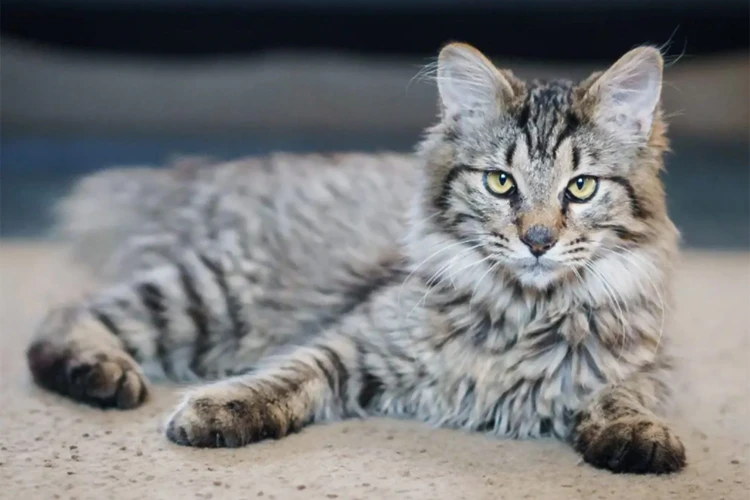
American Bobtail cats are known for their unique physical features which set them apart from other feline breeds. These features not only make them attractive but also make them functionally efficient in their day-to-day activities. The following aspects explain why American Bobtails are special:
Tail: The American Bobtail’s most distinctive feature is its tail which is short, only one-third of the length of a regular cat’s tail. In addition to their shortened tails, they have a kink at the end of their tail, which makes them look extra unique. This tail serves them well as they use it to maintain a balance while running and climbing.
Head: The American Bobtail has a broad head, similar to the shape of a modified wedge, and a distinctive, prominent brow line. This feature makes their face look more alert and gives them a more distinct appearance.
Ears: American Bobtails have lynx-like ears that are adorned with tufts of fur on the ends. These tufts of fur give them an extra dramatic look while also serving as a natural hearing aid. The tufts also help cushion the sound that enters their ears, allowing them to better tell the direction from which sounds are coming from.
Coat: The coat of the American Bobtail is thick, shaggy, and durable, making it easy to maintain despite their many activities. The fur is also naturally water-resistant, which helps protect them from the elements.
Paws: American Bobtails have large, round paws that help them maintain their balance, especially when climbing or chasing prey. Their front paws are usually heavier than their back paws, which gives them more stability and support.
Each of these facial and physical characteristics combine to give the American Bobtail a unique and attractive appearance. These features also help the American Bobtail perform well in their daily activities, whether they are climbing or playing. Due to their distinctive physical traits, American Bobtails are easily recognizable in any setting. Their unique and charming attributes make them a popular choice for cat lovers around the world.
Common Health Issues

Our feline friends are prone to specific health issues that can affect their overall wellness. The American Bobtail breed is not an exemption. Being aware of the common health concerns that may affect our furry companions can help us prevent or manage them effectively. In this section, we will discuss the health issues that are often associated with the American Bobtail breed, including hypertrophic cardiomyopathy, spinal defects, and urinary tract issues. By having an understanding of these issues, you can take the necessary steps to ensure that your American Bobtail remains healthy and happy throughout its life.
Hypertrophic Cardiomyopathy
Hypertrophic Cardiomyopathy is a genetic disorder that affects the heart muscles of the American Bobtail breed. This condition is characterized by the thickening of the heart muscles, which makes it harder for the heart to pump blood efficiently.
Here are some important facts you should know about Hypertrophic Cardiomyopathy in American Bobtails:
- It is a common health issue: Hypertrophic Cardiomyopathy is one of the most common health issues that affect the American Bobtail breed.
- It is a genetic condition: This condition is caused by a genetic mutation, which means that it is hereditary and can be passed down from one generation to the next.
- It can develop at any age: American Bobtails can develop hypertrophic cardiomyopathy at any age, but it is usually more common in older cats.
- Symptoms: Some of the symptoms of Hypertrophic Cardiomyopathy in American Bobtails include difficulty breathing, coughing, lethargy, and fainting.
- Treatment: Although there is no cure for Hypertrophic Cardiomyopathy, treatment options are available to manage its symptoms. These can include medication, surgery, and lifestyle changes.
- Prevention: It is important to screen American Bobtails for Hypertrophic Cardiomyopathy before breeding. A genetic test is available to screen for the condition, and breeders should only breed healthy cats without the mutation.
It’s important to note that not all American Bobtails with hypertrophic cardiomyopathy will show symptoms, so regular check-ups with a veterinarian is essential to keeping your pet healthy. If your American Bobtail is diagnosed with Hypertrophic Cardiomyopathy, your veterinarian will work with you to create a customized treatment plan that addresses your pet’s specific needs.
Spinal Defects
The American Bobtail breed is generally a healthy one, but there are some common health issues that may arise, such as spinal defects. These defects may be caused by genetics or environmental factors and can result in a variety of issues, including paralysis or partial paralysis.
Some of the most common spinal defects found in American Bobtails include:
- Lumbosacral transitional vertebra (LTV): This means that the vertebrae in the lower back are affected, causing pain and instability.
- Intervertebral disc disease (IVDD): This is a degenerative disease that affects the discs in the spinal cord, leading to pain, weakness, and, in severe cases, paralysis.
- Sacralization: This is when the lower lumbar vertebrae fuse together, causing issues with mobility and pain.
It’s important to note that not all American Bobtails will experience spinal defects, but it’s important to be aware of the signs and symptoms so you can seek treatment early on. Some symptoms might include difficulty walking, pain or sensitivity when touched, or a lack of coordination.
If you notice any of these symptoms or suspect that your American Bobtail has a spinal defect, it’s important to take them to the vet as soon as possible. Treatment options may include surgery, physical therapy, or medication. In some cases, specifically with IVDD, early intervention can make a big difference in the outcome for your cat.
As always, prevention is the best course of action. By ensuring that your American Bobtail is eating a healthy diet, exercising regularly, and avoiding situations that may cause injury to their spine, such as jumping from high surfaces, you’re taking important steps to keep them healthy and happy.
Urinary Tract Issues
Urinary tract issues are common among American Bobtail cats. It’s a frustrating and painful problem that requires veterinary attention. Symptoms of urinary tract issues include frequent urination, painful urination, bloody urine, and licking the genital area excessively.
There are several reasons why American Bobtail cats are prone to urinary tract issues. One of the main reasons is their diet. Cats need plenty of water to stay hydrated and to keep their urinary tract healthy. Unfortunately, many American Bobtail owners don’t give their cats enough water, and as a result, they become dehydrated. This leads to urinary tract issues such as bladder infections and kidney stones.
Another reason why American Bobtail cats are prone to urinary tract issues is their genetics. Some cats are simply more prone to urinary tract problems than others. In fact, male cats are more likely to develop urinary tract issues than female cats because their urethra is narrower.
To prevent urinary tract issues, it’s important to make sure your American Bobtail has access to plenty of fresh water. You can also feed your cat wet food, which is high in moisture and will help keep the urinary tract healthy. Regular vet checkups are also crucial to catching any potential issues early.
If your American Bobtail does develop urinary tract problems, it’s important to see a veterinarian right away. Treatment may include antibiotics, pain medication, and a special diet. In severe cases, surgery may be necessary.
Urinary tract issues are a common health concern for American Bobtail cats. Owners should make sure their cat has access to plenty of fresh water and a balanced diet to prevent these issues from occurring. Regular vet checkups are also important for catching any potential issues early. If your cat does develop urinary tract problems, prompt veterinary attention is crucial for effective treatment.
Grooming and Care
Keeping the American Bobtail groomed and healthy requires a certain level of attention and care. Their unique coat and other physical features require specific grooming techniques to maintain their health and appearance.
Coat: The American Bobtail has a thick, shaggy coat that requires regular brushing to prevent matting and tangling. Using a metal comb and slicker brush, gently brush their coat from head to tail, paying special attention to the areas where mats and tangles tend to form, such as behind the ears, under the chin, and on the belly. Bathing should be done infrequently, as frequent bathing can strip their coat of its natural oils. When bathing is necessary, use a gentle, cat-specific shampoo.
Eyes and Ears: The eyes and ears of the American Bobtail require regular cleaning. Use a soft wet cloth or cotton ball to clean the corners of their eyes, being careful not to touch the eye itself. For their ears, use a damp cloth to wipe away any dirt or debris, and be sure to keep an eye out for any signs of infection or infestation.
Paws and Nails: Keeping the American Bobtail’s paws clean is important for their overall health. Be sure to clean their paws after they use the litter box or go outside. Trim their nails regularly using sharp, cat-specific nail clippers, being careful not to cut too close to the quick.
Dental Care: Maintaining good dental hygiene is important for the overall health of your American Bobtail. Brush their teeth with a cat-specific toothbrush and toothpaste at least three times a week.
Health: The American Bobtail is generally a healthy breed, but like all cats, they can be prone to certain health issues. Regular vet check-ups and vaccinations are important to maintain their health, and any signs of illness or discomfort should be addressed immediately.
By following these grooming and care tips, you can help ensure that your American Bobtail remains healthy, happy, and beautiful for years to come.
Conclusion
After understanding the unique facial features of the American Bobtail breed, it is clear that this feline is quite special. From its distinctive head shape to the expressive eyes, the American Bobtail is a stunning animal that captures the attention of all who encounter it.
But it’s not just their looks that make them stand out. The American Bobtail’s size and demeanor make it a great companion for families of all types, including those with children and other pets. And their signature short tails give them a quirky charm that is hard to resist.
However, it’s important to note that proper care and attention is necessary to keep these amazing cats healthy and happy. Regular grooming, including brushing and cleaning of the ears, is crucial, and owners should be vigilant for signs of any health issues.
All in all, the American Bobtail’s unique facial features and overall personality make it a beloved breed among cat enthusiasts worldwide. If you are looking for a feline companion with a distinctive look and wonderful temperament, then the American Bobtail just might be the perfect match for you.
Frequently Asked Questions
What is the origin of the American Bobtail breed?
The American Bobtail breed originates from the United States.
What is the typical lifespan of an American Bobtail?
The average lifespan of an American Bobtail is 13-15 years.
Do American Bobtails have any unique personality traits?
American Bobtails are known for their loyal and affectionate personality, as well as their intelligence and playfulness.
What sets the American Bobtail apart from other cat breeds?
The American Bobtail’s unique facial features and wild appearance set it apart from other cat breeds.
Are American Bobtails good with children?
American Bobtails are generally good with children and make great family pets.
Do American Bobtails require a lot of grooming?
American Bobtails have a short to medium length coat that only requires occasional brushing.
What is the demeanor of the American Bobtail?
American Bobtails have a friendly and outgoing demeanor, but are also independent and self-reliant.
What type of diet should I feed my American Bobtail?
American Bobtails should be fed a high-quality, protein-rich diet that meets their nutritional needs.
Are there any health issues that are common in the American Bobtail breed?
Common health issues in the American Bobtail breed include hypertrophic cardiomyopathy, spinal defects, and urinary tract issues.
Is the American Bobtail an indoor or outdoor cat?
The American Bobtail can be an indoor or outdoor cat, but it is best to keep them indoors to keep them safe from potential hazards.

